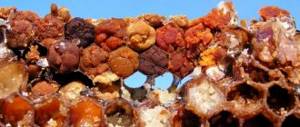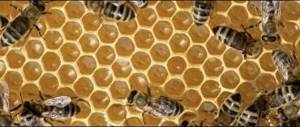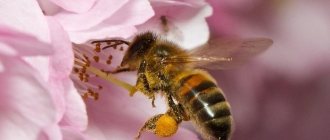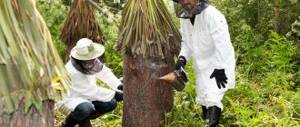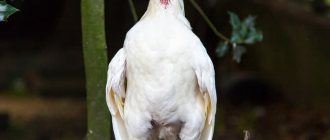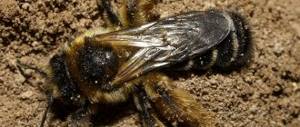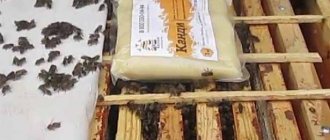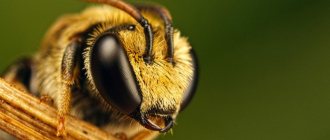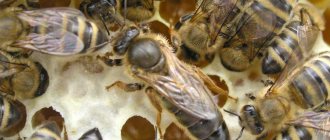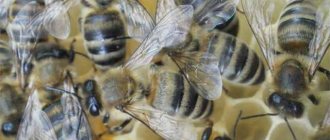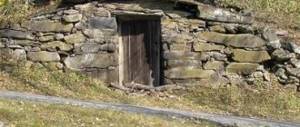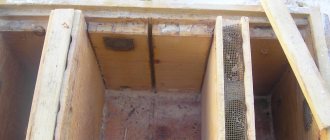Honey does not immediately reveal all its secrets. In order to be fully saturated with healing power, it must remain in the honeycomb for at least 7 days. Only in this case is the inversion completed and it is enriched with healing enzymes and amino acids that are so beneficial for the human body.
But the unripe product is saturated with water, as a result of which it does not last long. Therefore, it is so important to carry out the pumping process correctly and on time, which will be discussed in this article.
First collection
Experienced beekeepers know when it is time to make the first honey collection. When a bee fills a comb, it does not initially seal it until it has completed the entire process. And only then does the worker seal the cell with wax, thereby isolating it from the external environment and contact with air. Such a “canned” product can be stored indefinitely without losing its basic properties, characteristics and parameters.
But some unscrupulous beekeepers may take away the product while the insects are still collecting honey. In this case, honey from bees exceeds the water content by 2 times from the prescribed norm. Most often this is done due to a lack of cells.
The period when the first collection begins depends on the region, weather conditions in a particular season and climate zone. In the middle zone, the first pumping of honey from the honeycombs, as a rule, does not bring a bountiful harvest in comparison with the last. It falls at the end of June in the middle zone.
Naturally, in the southern parts the process is combined with the first half of the month, and sometimes begins at the end of spring. Therefore, beekeepers need to constantly monitor the presence of sealed honeycombs and take honey from the bees if there are prerequisites for this.
Obtaining the May product is available to beekeepers who have some experience in beekeeping. And, of course, this can be done if there are plantings of fruit trees, dandelion thickets or a sufficient amount of willow near the beehives. The weather in spring also plays an important role. If this season is rainy, then insects cannot fully collect pollen, and, accordingly, pumping honey from the honeycomb will also be delayed.
What methods exist
Collecting honey from honeycombs is a responsible task. Until 1865, collection was carried out using one single method: the honeycombs were placed under a press, and the resulting impurities and debris were removed through gauze. Modern beekeepers use various types of honey extractors.
To start collecting, the honeycombs should be printed. This is done manually or with special automatic devices. For small farms, forks (cut off the top, sealing layer) or a roller with needles (pierces the bar) are suitable.
The extraction technique depends on the type of honey extractor. The essence of the mechanism is that under the influence of centrifugal forces, honey comes out of the honeycomb, small drops fall on the walls of the device and flow into a special container. Honey extractors work in horizontal and vertical positions. Horizontal models operate radially or chordally.
Main honey collection
The main honey harvest period coincides with the flowering of linden and other main honey plants. Most often in the south, this manipulation occurs from mid to late August. In the middle zone - a little earlier. But the main thing is that it should not be held later than the end of August. This is due to the fact that the bees are beginning to prepare for winter.
You need to know that in addition to when to collect honey, you need to know how many times you can pump it out in 1 season. Some argue that selection can be done twice. But this is nothing more than a myth. It is necessary to focus, first of all, on the productivity of flowering plants, that is, the abundance of color on them. If the summer turns out to be fruitful, then pumping can be done up to 4 times:
- The second (the main honey flow) comes around the end of June.
- Third manipulation in July.
- Fourth in August.
But, under no circumstances should it be allowed to be removed from the hive in September.
Also, those new to this business need to understand that it is not taken from the brood nest. Since it is a food source and is needed for insects.
Bees collect nectar
Nectar is contained in honey-bearing plants: flowers, shrubs, trees, for example, in birch earrings. The first honey plants bloom early, and the bees immediately get to work. In addition to earrings, birch trees pamper bees with their sap, and bees collect propolis from buds and leaves. It is impossible to say how many times a day a bee makes complex flights; we only know that this restless worker flies from dawn to dusk.
Insects see flowers completely differently. Nature has done its best to create conditions for insects that make it comfortable for them to land on them.
From the word “nectar” comes the name “nectarines” - parts of plants filled with sweet liquid, juice. It is thanks to them, or rather to their aroma, that plants owe the possibility of procreation.
Bribe, or, in other words, honey collection, is the name of the process when a bee collects nectar and brings it to the hive. Nature has endowed the bee with a proboscis, which she uses to collect nectar, which mixes with saliva in her mouth.
They work tirelessly, sometimes covering fantastic distances, and all because there is bribes and the opportunity to store them in the hive. The bee's body gets tired, it does not last forever, perhaps the insect realizes that if there is honey, the brood will be good, new bees will replace the dead flying bees, which means the winter will be prosperous. Somewhere on an instinctive level, the insect understands that the health and good wintering of the bees depends on how much honey is stored for the winter. The hard worker does not care about her well-being; she will not have a chance to taste honey while it ripens for a month in wax honeycombs; she will probably no longer be around.
Methods
Many inexperienced beekeepers find it difficult to select the correct methods for collecting honey. The fact is that if the apiary consists of several hives, then pumping can be done manually.
Otherwise, the lack of special devices will lead to too much time and labor. Therefore, in a large apiary it is necessary to use a honey extractor.
With a honey extractor
Honey extractors can be chordial or radial. It is the radial placement of the frames in the cassettes that allows up to 50 honeycombs to be loaded simultaneously into one cylindrical container.
And although it is pumped out faster from the chordial one, a maximum of 4 cassettes with honeycombs can be placed here in one load.
One more feature must be taken into account: the honeycombs should not cool down - the honey must be collected immediately, otherwise they will have to be heated at room temperature +27°C.
To print, use an electric knife. It is also acceptable to use a steam or hot apiary tool.
It is necessary to understand that wax, dead bees, larvae and other foreign substances get into the product when it is collected. Therefore, they use special mesh structures that are able to weed out everything unnecessary.
Without honey extractor
Here's how to properly collect honey without special devices:
Using a warm, heated fork or knife, open the honeycombs and place in an appropriate container for at least 1 day. In this case, honey spontaneously flows into the prepared container.
Then, once it is assembled, the wax material needs to be kept in cool conditions. And after that it will be possible to put the honeycombs back into the hive.
How to collect honey
Once it's time to harvest the honey, proper techniques will help you get as many jars of golden nectar as possible.
Extraction
Here is the step-by-step procedure for collecting honey:
- Use smoke to keep the bees docile while the hive is opening.
- Use hive tools to free the frames, as the bees will try to secure them in place with reinforcement wax. If the frame contains at least 80% of the comb covered in plaque, a soft bristle brush or light blower can be used to remove the bees.
- Cover the frames with a trap or cloth to prevent bees from settling on them, and isolate them before harvesting.
- Unsealing knives or scrapers can be used to remove the top layer of wax that seals the honeycomb.
- Once the honey is unsealed, the extractor uses centrifugal force to separate the honey from the honeycomb. The extractors are available in both electric and manual versions and allow the separated honey to accumulate in their reservoirs, from where it can be drained through a honey seal.
- Once separated, pass the honey through a sieve to filter out the last little bits of wax.
Without extractor
Many beekeepers use an extractor. This is one of the most expensive devices and is only used once a year, so it makes sense to use them together. Most beekeeping clubs have one or two that their members can borrow.
If for some reason you don't have access to an extractor, there is another way to access the honey. You can cut off the bar on the combs, and then simply let the honey drain into a large container. This is a much slower method and still needs to be filtered, but it works.
1-Cutting the bar 2-Honey in the combs
Raw honeycomb
The last option is to simply cut up the honeycomb, place it in containers and sell it as is. Many people prefer to consume honey this way. It tastes the same but looks more authentic and customers can rest assured that it has not been watered down or processed.
Tools
The following tools are used:
- Honey extractors – chordial, radial.
- Hot electric knife.
- Or a simple kitchen tool that needs to be heated before opening the honeycomb.
- And of course, a smoker in those cases when you need to drive bees off the frame.
- A spray bottle for spraying honeycombs with warm water in case of pumping out candied honey.
Step by Step Process: How Bees Make Honey
Collecting honey is what bees do all the time, they live by it. Absolutely all minke whales are involved in this important family business. Each of them plays its role (Figure 1).
Let's describe this process in more detail:
- Bees begin to work in the spring, when the air warms up above +14 degrees. Then the bee makes its first flight, inspecting the territory.
- Having examined her possessions and found a place where she can collect nectar, she remembers it and hurries to the hive to gather a team for honey collection. And then, he leads the working women to the working field. She makes such flights every day.
- Interestingly, not all bees fly to work. Some remain in the hive and do other work. Some make honeycombs so that they have a place to collect honey, while others wait for the worker bees to bring the nectar collected from the field.
- Having received nectar, the receiving bees carry it to the honeycombs and begin to process it into what we call honey.
Figure 1. Bees process the collected nectar into honey.
Next, the finished product is sealed with wax stoppers and left to mature. In this way, the bees seal the honeycomb hermetically, and it can be stored for a long time.
Tara
Naturally, for pumping and storage they use containers that do not have any foreign odor. It must be made of materials that have the right to come into contact with food. It can be:
- Metal containers with a varnished internal coating.
- Wooden.
- Ceramic with glazed coating on internal surfaces.
- Aluminum flasks.
- Glass.
Of course, it is desirable that the container for the honey collector complies with GOST 54644-2011. And you should not store honey in containers larger than 3 liters.
By following all the recommendations, you can easily carry out the correct pumping of honey without harming the insects and obtaining the long-awaited high-quality honey and bee products.
Methods for effective use of honey collection
The guarantee that bees will take full advantage of the honey harvest period is a large number of bees in the colony during the main honey harvest period.
This is achieved thanks to good ventilation and shading of the hives, the use of honey layerings with young (hatched in the spring) queens, and migrations with bees during honey collection.
Ventilation and darkening
In extreme heat, bees themselves ventilate their homes, but this does not mean that they do not need help.
Proper ventilation and shading of hives can significantly increase the productivity of bee colonies in the apiary. To enhance ventilation in hives with removable bottoms, the hive body is raised above the bottom from the front side using wedges. This creates a small (4-5 mm) gap along the entire length of the hive, which helps improve ventilation. If the bottom of the hive is not removable, it is necessary to completely open the entrance and open all the ventilation holes.
To increase ventilation, Bashkir beekeepers bend a canvas from the back wall of the hive, which is located behind the nest, creating free space up to 2 cm wide above the frames.
Natural shade is the best place for hives in the heat.
During honey collection there is no reason to fear the onset of bee theft. If the bribe weakens or stops abruptly (due to weather conditions), all actions to increase ventilation should be stopped and quickly curtailed, since now is the time to start preventing bee theft in the apiary.
Shading the hives from the scorching sun also has a positive effect on the flow of honey collection. It has been found that shaded hives increase productivity by 5-10%. In addition, shading reduces the likelihood of swarming.
Bees need to be protected from fields treated with insecticides
Bee houses are shaded using various types of shields made of straw, reeds or other material. The main thing is that the shield covers the front wall of the hive with ventilation holes, the entrance and the landing board from the sun. If the roofs of the hives are iron, then straw mats are laid under them. With the correct placement of houses in the apiary, when the shade of trees and shrubs is used, there is no need for artificial shading.
Nomadic apiary
Large honey yields are obtained through nomadic apiaries. To improve the productivity of an apiary, it is not enough just to properly care for it; sometimes it is necessary to “push” the bees into a big bribe. For this purpose, the apiary is transported to plantations of various honey plants. Thus, the beekeeper increases the duration of the bribe period, which allows him to collect more honey.
Small nomadic apiary
The migration plan is drawn up in advance, starting in early spring. In this regard, the flowering calendar of honey plants will provide invaluable assistance, which will allow you to determine the timing for increasing the strength of the family, as well as the time for moving the apiary from one place to another.
It should be remembered that before bringing the apiary to a particular field, you should talk with the agronomist to ensure that there are no insecticides that can cause irreparable damage to the bees in a matter of hours.
A nomadic apiary is no different in its organization from an ordinary one. It is only necessary that the bees are prepared for transportation.
To avoid problems during migration, a number of operations are carried out:
- improve ventilation of hives;
- securely fasten the individual parts of the hive together and fix the position of the frames in the nest;
- Replace frames with light (recently built) honeycombs and heavily filled with honey with frames with dried honey.
To improve ventilation, special frames are used that adjust the size of the hive. They are covered with a metal mesh. During transportation, the insulation and ceiling coverings (canvas) are removed from the hive, and a manufactured frame is used instead of a roof. If there are not enough frames, then you can use magazine bodies onto which a metal mesh is stretched in advance.
Nomadic apiary near a rapeseed field
It is best to use a mesh with hole sizes of 2x2 mm or 2.5x2.5 mm. With smaller sizes, ventilation of the nest will be insufficient, and a larger mesh will allow bees to poke their heads into its holes, which will ultimately significantly reduce ventilation.
All parts of the hive should be securely fastened together with wooden slats so that it does not come apart during transportation. For the same purpose, you can use a rope clamp.
The frames should also be secured to prevent them from swinging. It is very good if frames with extensions on the side bars are used. Such frames cannot swing during transportation and are therefore optimally suited for wandering. Otherwise, you should use small blocks separating the frames. They are made about 10-15 cm long and 12-15 cm thick, the width of the street. It doesn’t hurt to drive a nail at one end of the block so that it protrudes a few centimeters on both sides. In this case, the bars can be hung on frames.
It is best to transport bees early in the morning or evening. Before this, the hives should be carefully inspected and all cracks should be covered with clay. Then you need to wait until the bees stop flying and cover the entrances with tow or moss.
Insects are most often transported on trailers, on which, before installation, straw or hay is laid in a layer of up to 50 cm. When driving on flat sections of the road, you should not slow down, since when driving fast, the bees will suffer less from stuffiness. If you put boards on the roofs of the hives, you can install a second tier of houses on top.
It is very convenient to equip a permanent trailer with beehives for wandering. It is easily transported from one honey plant to another. It’s even better to equip a trailer in which the hives are installed, and holes for entrances are made in its walls. Bees can even spend the winter in such a trailer.
Upon arrival at the site, the hives are placed at a point, the roofs are put in place, the entrances are opened and the bees are allowed to calm down. The next day, an inspection is carried out, during which the frames are removed, the blocks are removed, and frames with broken honeycombs are discarded.
Why do bees need pollen?
Nectar and pollen are the main components of the future sweet product. They play a decisive role in the aromatic and taste qualities obtained at the output. Let's take a closer look at what functions pollen performs.
Interesting things about bees. A honey insect can fly into someone else's hive deliberately. The reason is the plunder of a weaker family, when there is a problem with bribes around, or the inability to return to her family (late, cold, rain) - in this case, she takes a pose of humility, and the guards let her through.
Honey plant pollen is necessary not only for making honey, but also for feeding all the inhabitants of the apiary. Honey elixir is a vital component of the bees’ diet, without which they will not survive and will not have enough strength to work, as well as to produce royal jelly. The queen consumes nectar until she reaches adulthood, working class bees only for 3 days.
Another category of insects in the apiary are builders. They also need nectar and pollen, because they help their wax glands work efficiently, so the bees can build high-quality, strong honeycombs to store honey.
Pollen is also necessary for drones, which act in the apiary as inseminators of females. The lack of such a vital component threatens an incorrect and lengthy process of puberty, as well as a lack of strength to fulfill one’s main responsibilities.
In addition to all of the above, pollen and nectar are a kind of “test” for beebread; bees noticeably weaken without it in winter.
Now you know the role of pollen and its necessity for each member of the working insect family.
Honey volumes depending on location
Naturally, in Russia, as in other countries of the world, there are regions where beekeeping and beekeeping are strongest. This is due not only to traditions and cultural characteristics, but, first of all, to favorable conditions and a strong food supply. Accordingly, the amount of harvest in each area will vary greatly.
Regions of Russia
On the territory of Russia, in different regions, they collect, as a rule, from 6 to 18 kg of honey for sale. The most honey-rich regions can be considered Tatarstan, Bashkortostan, Altai, Primorye, Krasnodar, and Rostov region. In a year, beekeepers here receive up to 50 kg - this is the amount of sweet nectar produced by one hive.
In Ukraine
In Ukraine there is some distribution, in terms of varietal and honey, and territorial division. So, there is the following predisposition:
- This is how the buckwheat variety is harvested in the central and western parts of the country.
- In the eastern and southern territories, sunflower and acacia honey are most often extracted.
- The maximum yield is observed in the forest-steppe zone, where rapeseed, buckwheat, and linden grow. The average from one hive is up to 16 kg per season.
On the territory of the Republic of Belarus
In the country, an average of 14 kg of sweet bee nectar is obtained from 1 bee house.
Bashkir honey from a leading producer
is a popular and recognizable brand that does not require advertising in Russia and even abroad. The quality of the products is ensured by professional details of honey collection and strict compliance with the deadlines for honey collection. Many years of activity and study of production details have provided the company with a high reputation.
To obtain high-quality honey collection, the company organized areas in environmentally friendly places in the republic. Experienced beekeepers collect honey from hives and collect it in forest edges. A bort is a hollow in a tree trunk where bees carry out their life activities without human intervention. There are no frames, so beekeepers, when collecting honey, extract the honeycombs in the same form as the insects created it.
The product, obtained from wild bees, is a particularly unique mixture. It contains wax, drone brood, milk, nectar, pollen, and beneficial bee venom. It is removed once a year, mainly in late summer - early autumn. The product has a dark brown tint and has a pleasant subtle aroma.
It contains the most beneficial substances for the body: amino acids, enzymes, glucose, vitamins and minerals. The quantitative composition of nutrients changes every year, but their beneficial properties do not deteriorate. On-board honey belongs to the “platinum” category.
List of all plants and flowers from which bees collect honey (including red)
Did you know that the honey bee not only produces honey, but also plays a major role in pollinating crops.
Each bee works almost all day non-stop, collecting pollen and delivering it to the hive. The process of collecting pollen necessary to create nectar with further transformation into honey does not occur from all types of honey plants, which include many plants and flowers. The most popular and widespread honey plants:
- early honey plant - coltsfoot grass. It produces not only nectar, but also pollen, and also has a lot of useful properties. Productivity – about 50 kg per 1 ha;
- cone-shaped burrow - located in shady areas with moist soils. Flowering June – September. Productivity – on average 1.2 tons per 1 ha;
- medicinal dandelion is one of the most common plants on Earth; the flowering period begins in July. The average productivity is 80 kg per 1 ha;
- mint - most often found in soil with high levels of humidity. Flowering – June – September. The average honey collection is 1.1 tons per hectare;
- Medicinal lungwort is one of the early honey plants. Flowering April – May. It grows only in forests. The average honey collection is 55 kg per 1 ha;
- noble coppice, also grows mainly in forests. Flowering - early spring;
Little tricks of beekeepers when collecting honey. The beekeeper enters the hive if he is not afraid of being stung, or drives away the swarm with smoke. However, it does not calm the insects with smoke: thinking that a fire is starting, they collect a strategic supply of honey, and with their bellies full, they can no longer release their stingers.
- meadow cornflower – from June to September there is a flowering period. The average harvest from 1 ha is 100 kg;
- common blackhead grass - like mint, loves moist soils, blooms from June to September. Nectar collection - on average 110 kg per 1 ha;
- autumn kulbaba – average productivity is standard, up to 85 kg per hectare. Flowering July – September;
- white clover (legume family) - flower activity from May to early June. Honey collection - up to 110 kg per 1 ha.
Honey flowers include:
- sweet clover;
- chicory;
- meadow geranium (crane geranium);
- common sunflower;
- chamomile;
- field and meadow cornflowers;
- colchicum (colchicum);
- common dandelion;
- English mustard (white);
- blackhead;
- marsh honey plant aster;
- lilac.
From which plant do bees collect red honey?
Interesting fact.
The path that a strong bee colony flies during the main honey collection is in total equal to the distance from the Earth to the Moon. In addition to the classic varieties of honey, there is rare red honey in nature. Place of manufacture: Nepal. To collect pollen and nectar, bees need a special flower that grows high in the mountains - rhododendron. Producers of red honey are large bees Apis Laboriosa, living in nests on steep cliffs at an altitude of about 3000 m. This type of honey has a greater range of beneficial properties than any other varieties.
Among the features of red honey are the rejuvenating effect, slowing down the aging process and strengthening the body's defenses and immunity.
Pasteurization of honey
If honey is stored in glass jars, proceed as follows. The pumped out honey is immediately poured into a clean, dry jar, sealed tightly with a lid (it is first treated in boiling water for 2-3 minutes, then dried). Place jars of honey in hot water and pasteurize (with a barely noticeable shaking of the surface of the water) for 15-20 minutes. After this, the honey remains liquid, without losing either smell or taste. However, it must be borne in mind that when heated to 60°C and above, honey enzymes are inactivated.
In what month does honey flow begin?
Depending on the climate zone, honey harvesting time in Russia begins at the end of spring or at the beginning of the summer season. The first fields of dandelions, trees and bushes already mean that it is time to release the bees for the spring flight. This period is very important for them, because during the winter season they do not receive useful raw materials. The first flight is called a cleansing flight - during it, the bees unload the intestines from feces, which improves their vital functions and promotes the good development of bee colonies.
The main honey collection can begin when the bees have already passed the swarming period - this occurs in June (the middle of the month), when the flowering of honey plants is already considered active. At this time, the number of individuals reaches its maximum values and they are ready for the main bribe. By filling the frames with nectar, they store a large amount of honey.
An experienced beekeeper, having prepared all the conditions for the bees, begins pumping already in June and continues to do this throughout the summer period. But it is the knowledgeable owner who is in no hurry to benefit from pumping out the first portion. It is important that the honey becomes mature, filled with aromas, enzymes and beneficial acids. Only then will the honey collection be of high quality.
Being engaged in beekeeping, the owner of the apiary is familiar with all the nuances on which the quality of the product depends. The time for collecting honey continues throughout the warm period, when the plants periodically change - the flowering of clover, raspberries and rapeseed is replaced by linden, sage, lavender; in August the herbs are fragrant. And each batch of honey has a unique color, taste, and aroma.
When the beekeeper stops pumping, his work does not end there. Before the onset of cold weather, it creates conditions for the bees for a comfortable and successful winter. By selecting certain frames, he leaves part of the honey to feed the families.
Nectar collection
The process is complex and begins from the moment the bees fly out of the hives with the arrival of spring. The first forest honey plants, the flowers of the trees are used to collect nectar and pollen. Each working individual has a special proboscis (zobot) with a long tongue, with which it collects nectar. This organ is penetrated by blood vessels and glands that produce peculiar enzymes. With their help, nectar is broken down into sugar.
Nectar consists of water (80%) and sugar. You can simply see its nectar with the naked eye. It is enough to tear the flower from the cutting; a drop of clear liquid appears and there is nectar. The first flower honey plants include:
- dandelions;
- color of fruit trees;
- clover;
- lungwort growing in the forest;
- snowdrop;
- scillas;
- violets;
- color of bushes.
A worker bee has two stomachs. One stores the collected nectar. The other is for food. To fill the stomach with nectar, the bee will have to fly around more than one and a half thousand honey flowers. The volume of this ventricle is extremely small, only 70 mg.
Interesting!
The weight of a bee is equal to the weight of a stomach filled with nectar.
The bee returns to the hive when the stomach is full. In the hive, it passes the collected nectar to another worker, who takes everything using a long tongue. Part of the nectar is used to feed the larvae, the rest is processed.
But even now it is not clear how bees make honey from the nectar they bring.
Distribution of responsibilities in the hive
A bee family consists of a large number of individuals (25-60 thousand), each of which performs certain functions.
- The queen is the only one, the largest bee. She is assigned the role of laying eggs to produce offspring.
- The drone is smaller, but wider than the queen. It carries out fertilization of the uterus. There are several such males in the hive. They are distinguished by large eyes. The organ of vision is useful in flight. The drone must catch the queen and mate on the fly.
- Worker bees are a large part of the family. Each one does a specific job in the hive. They fly over to search for honey plants (scouts), collect and process nectar.
So who taught the bees to collect honey? This is a merit of nature. The scouts fly around, find honey plants, return to the hive and with their dance let the worker bee know in which direction to fly to collect nectar.
Honey plants
The working individual makes its first flight from the hive when the air temperature is not lower than 8 degrees and the first honey plants appear from under the snow. The most active flight occurs during the linden flowering period. The color of this tree is the best honey plant. They take nectar from the following flowers:
- pear, cherry, apricot color;
- willow;
- buckthorn;
- viburnum;
- forest and garden raspberries;
- hazel;
- Rowan;
- plum;
- currant;
- blueberry;
- Apple tree;
- thyme;
- bird cherry;
- sunflower;
- buckwheat;
- blackhead;
- mint, lemon balm;
- cornflower.
If a beekeeper suspects that his families do not have enough honey plants, he plants his own plot or takes the hives to other places. In the area of fields with blooming buckwheat, sunflowers, linden groves, meadow or mountain grasses.
